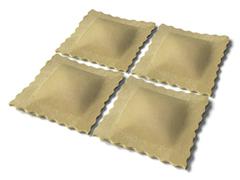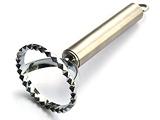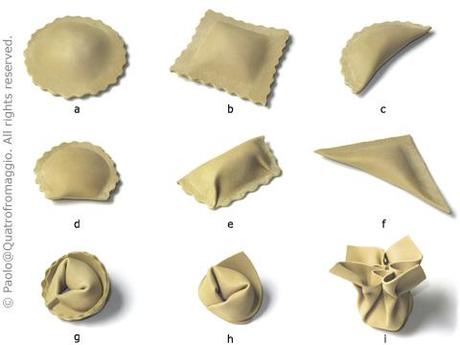 The word 'ravioli' (plural of 'raviolo') refers to all kinds of filled Italian pasta where a thin layer of dough wraps around a filling ('ripieno', in Italian). Ravioli are either boiled and dished out with sauce (a popular first course), or served in broth (a classic dinner option, especially during winter). The pasta layer, generally egg-based and rolled into a thin sheet, serves as more than an enclosure - it overextends around the filling and binds with the sauces or the broth. Common fillings may include meat, cheese, vegetables and vary greatly between the countless regional recipes. Special types of deep fried sweet ravioli also exist, perpetuating a tradition that goes back to the earliest written documents on filled pasta.
The word 'ravioli' (plural of 'raviolo') refers to all kinds of filled Italian pasta where a thin layer of dough wraps around a filling ('ripieno', in Italian). Ravioli are either boiled and dished out with sauce (a popular first course), or served in broth (a classic dinner option, especially during winter). The pasta layer, generally egg-based and rolled into a thin sheet, serves as more than an enclosure - it overextends around the filling and binds with the sauces or the broth. Common fillings may include meat, cheese, vegetables and vary greatly between the countless regional recipes. Special types of deep fried sweet ravioli also exist, perpetuating a tradition that goes back to the earliest written documents on filled pasta.The recipe book "Liber de Coquina" (Naples, end of 13th century) defines "torta" a thick pie shell used as a sealed pot and not meant to be eaten. The torta was filled with a mixture of minced meat, grains, vegetables and spices, and placed in the bread oven(1). Large and elaborate versions of the torta - made of multiple layers and decorated with plums - were served in important banquets, whereas simpler preparations were accessible to everybody.
Inspired by the idea behind the torta, pasta makers started to incorporate similar types of fillings into their pasta shapes. The word 'tortello' (small torta) was used to refer to the pasta enclosure, whereas the word 'raviolo' (probably from late Latin rabiòlæ) was generally used to refer to just the filling. In addition to being boiled and served with sauces, the savory-filled tortelli were also fried and served with sugar and honey(1).
As a testament to its ancient origins, filled pasta changes name and often also shape, size and fillings based on the region of Italy. Here is a list of the most popular kinds:
- Agnolotti (Piedmont, and other northern Italian regions) are made by layering two sheets of dough and cutting out a circle (a) or a square (b), or by folding a circle or square of dough in half (creating a half-circle shape (c) or a rectangle). If the folded agnolotti are pinched, they are called "al plin" (e). Agnolotti are usually relatively large (⌀ 50 mm). The traditional Piedmontese style is filled with braised beef, ham, spinach, Parmesan and egg, and served with the gravy from the beef or with butter (with optional sage or truffle) and Parmesan(2).
- Anolini (provinces of Parma and Piacenza) are medium-sized (⌀ 40 mm) and generally round (a, in the picture below) or almost half-circle shaped (d), cut with a circular pasta cutter. Usually, anolini have meat-based fillings and are served in broth or with a sauce made from beef.
- Cappelletti (Emilia-Romagna, but especially Romagna) are slightly larger than 'tortellini', about 30 mm in diameter. They are obtained by placing the filling in the middle of squares of pasta dough, then by folding the dough diagonally to form a triangle, and by wrapping it around a finger until the opposing corners overlap and can be pressed together (h). The name 'cappelletti' means small hats in Italian, from the resemblance of the finished product to small paper hats. The filling generally includes different kinds of meat (pork, veal, prosciutto) and Parmesan. Cappelletti are normally had in chicken broth.
- Casoncelli (Lombardy, and particularly Val Camonica, Bergamo and Brescia) are medium-sized (⌀ 40 mm), generally in the shape of an half-circle (c), or of a candy wrapper. The fillings used in casoncelli vary substantially based on the area in which they are made, even from town to town. The ones from Bergamo are filled with veal, sausage, rasin, spices (cinnamon, nutmeg, pepper), Parmesan and breadcrumbs. They are generally served with melted butter (with optional 'pancetta') and sage.
- Fagottini or Sacchetti are a modern creation, their shape is obtained by closing squares of pasta dough to form small bags (i) around meat-based or vegetarian fillings.
- Pansotti (Liguria) are quite large (⌀ 50 mm) and made by cutting squares or circles of dough and folding them in half (c, f). The name means "big bellies" in Italian dialect. Traditionally, the Genoa-style pansotti are filled with ricotta, Parmesan, endive, turnip and garlic, and served with a sauce made with walnut, milk and bread(2).
- Ravioli (whole of Italy) are usually square with a side of about 40 mm. They are made by layering one sheet of pasta dough, small lumps of filling, and another sheet of pasta dough. A common variety is filled with spinach, ricotta and Parmesan(2), a type of filling which is called 'di magro' (literally, "lean" in Italian). This name was introduced by the Catholics to indicate that the filling doesn't contain meat and this dish is allowed to be consumed during Fridays in Lent. Another variety is the Neapolitan-style, filled with ricotta, Parmesan, parsley and egg, and generally served with tomato sauce and Parmesan(2). Ravioli with meat or fish-based fillings are also popular.
- Tortelli (all northern Italy) are commonly square and flat (b) with a side of 50 mm, but they may also be round (a), or half-circle shaped (c). In some cases they may also look like big 'tortellini' (g). A famous kind of tortelli from Lombardy is 'Tortelli con la Zucca', filled with pumpkin, Parmesan, bread crumbs and eggs, and usually served with butter and sage(2). Tuscan-style tortelli, instead, have a meat-base filling. Just like in Medieval times, sweet versions of tortelli also exists; nowadays, however, they tend to have more neutral fillings (e.g.: ricotta and cinnamon) and they are sometimes cooked in the oven instead of being fried in oil. A different kind of sweet tortelli is 'Tortelli Cremaschi' (from the city of Crema), which have a sweet filling, savory pasta dough and savory serving sauce (butter and Parmesan). The filling is made with ground 'mostaccini' (spiced hard cookies typical of Crema), ground 'amaretti' (almond macaroons), raisins, candied citron peel, lemon zest, egg, Parmesan, Marsala liquor, nutmeg and (optional) ground mints. This dish is served in special occasions and during the traditional mid-summer festival.
- Tortellini (Emilia-Romagna, but especially Emilia and particularly the cities of Bologna and Modena) are quite small (⌀ 20 mm) and have a shape similar to 'cappelletti' except that they are usually made starting from a circle of pasta instead of a square (g). The name is a diminutive of 'tortelli'. The filling is usually meat-based (mortadella, prosciutto, veal, Parmesan, egg(2)). Tortellini are commonly served with tomato sauce or in meat broth.
- Tortelloni (northern Italy), are generally a larger version (⌀ 30-40 mm) of tortellini (g) or cappelletti (h), but they may also be a larger version of the flat tortelli (b). Tortelloni may have several types of fillings, both meat-based and vegetarian. A well known filling is mushroom-based (with porcini mushroom, ricotta, onion, Parmesan), served with butter and sage(2).

Circular pasta cutter

Common shapes of Italian filled pasta
(1) "Italian Cuisine: A Cultural History" by Alberto Capatti and Massimo Montanari - Columbia University Press. ISBN: 978-0-231-12232-0
(2) "The Silver Spoon" - Phaidon Press. ISBN: 978-0-714-84531-9

